Description of previous item
Description of next item
Black Friday: The Life and Death of Florida's Shopping Malls
Published November 11, 2016 by Florida Memory
For many Floridians, the day following Thanksgiving is something of an unofficial holiday–one marked by the custom of camping out in front of stores in search of the greatest deals on gifts for the holiday season. This Black Friday, we take a look at the history of a familiar, increasingly antiquated structure: the Florida shopping mall.
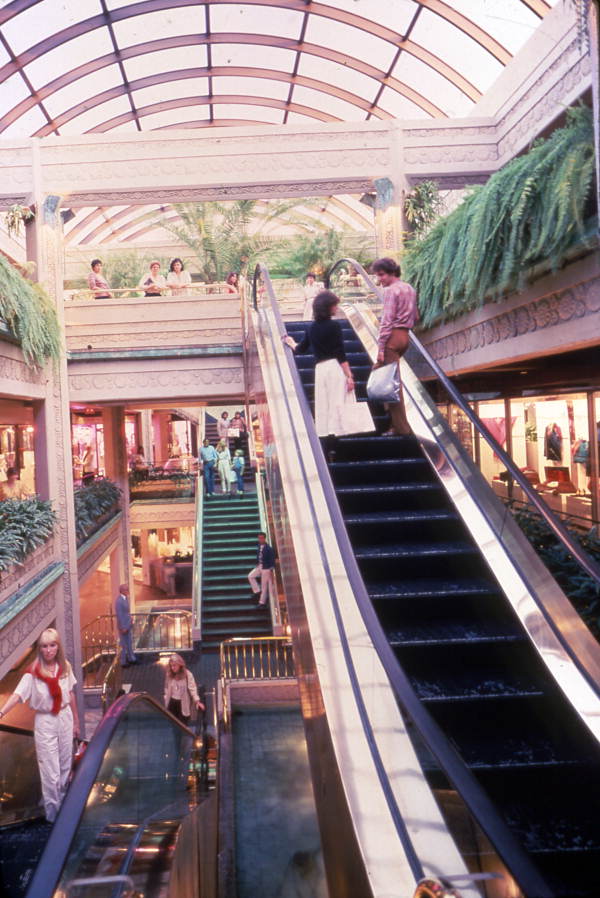
Interior view showing the atrium and escalators at Mayfair in the Grove Mall in Miami, ca. 1980.
Shopping centers are nothing new. The original “malls” were open-air markets, dating back to the Roman forum or the Greek agora. However, the American shopping mall as we know it today is a product of the rise of consumerism after WWII. The modern shopping mall was originally invented by Victor Gruen, an architect and refugee of Nazi-occupied Austria who came to the United States in 1938. Gruen conceived of the mall as a community center, in which people could socialize, walk, dine and shop just as they did in his home city of Vienna. Gruen is best-known for designing the Southdale Mall in Minnesota. Built in 1956, Southdale was the first fully air-conditioned, enclosed, two-story mall. The space centered around a square, complete with sculptures, greenery and water features. The unprecedented comfort and convenience at Southdale set the stage for the ensuing American shopping mall phenomenon.
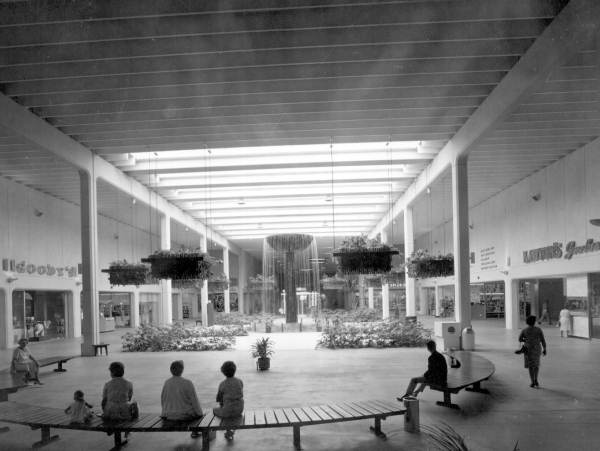
Interior of the Winter Park Mall with a fountain, Winter Park, Florida, ca. 1959.
Gruen’s vision of building commercial utopias influenced other entrepreneurs of the era, such as the founder of Publix Supermarkets, Florida businessman George Jenkins. In 1947, Jenkins visited his first shopping center in St. Louis, and ultimately decided to pattern his stores based on this model. Jenkins opened his first shopping center in 1956 in Largo, and soon opened more locations in Sarasota and Winter Haven. The Southgate Center in Lakeland, built in 1957, boasted 16 stores, including a Woolworths, a hardware store, and a shoe store, all anchored by a Publix featuring Jenkins’ latest innovation, the in-store “Danish Bakery.” Equipped with ample parking, a plethora of stores and air conditioning, these shopping centers were the true predecessors to shopping malls in Florida.
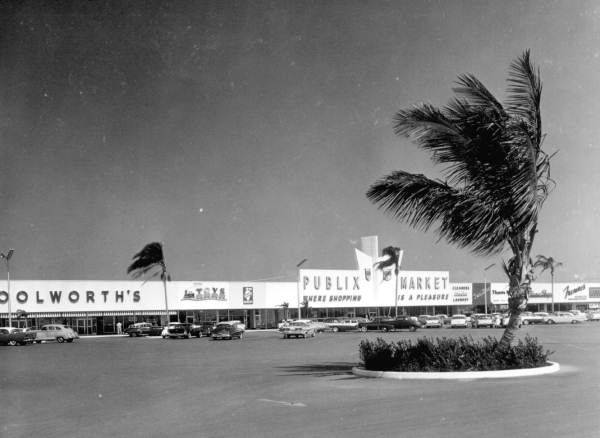
Shopping center in St. Petersburg, 1958.
The proliferation of shopping malls mirrored the rise of the automobile and the post-war white flight from urban centers to suburban neighborhoods. Meanwhile, Congress enacted the Internal Revenue Code of 1954, granting tax deductions to developers equal to one fortieth of the value of their development projects. This would account for the eventual depreciation of the value of the structure (that the developer, hypothetically, would have to re-build in an estimated forty years). These tax reforms were intended to stimulate manufacturing, but they also provided incentive for developers to build the largest, most opulent structures possible in order to deduct proportionally grand sums from their annual incomes. These tax reforms, coupled with the growing buying power of the white middle class, created a veritable gold rush for the construction of shopping malls.
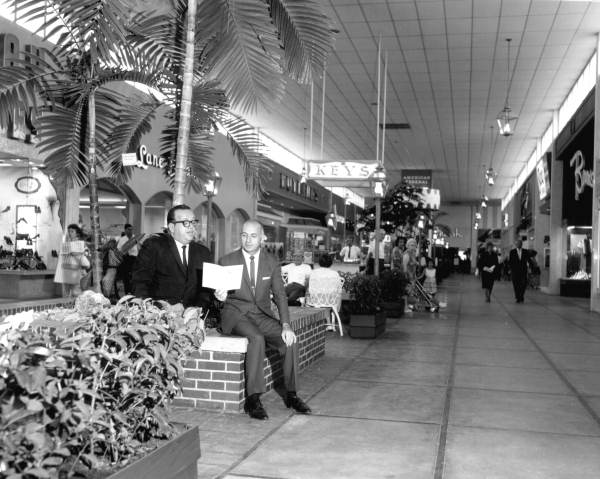
Interior of the Colonial Plaza Mall, Orlando, Florida, 1966.
Malls hit the scene in Florida in the 1960s. The Winter Park Mall arrived in 1959, and featured a garden of tropical plants with a 25-foot champagne glass fountain at its center. Coral Ridge Plaza in Ft. Lauderdale and Colonial Plaza Mall in Orlando were soon to follow, both built in 1962. The Northwood Mall in Tallahassee, erected in September 1969, was the first mall built in the state capital, and offered a variety of clothing retailers, a luxury jeweler, a toy store, several restaurants, and a Publix.
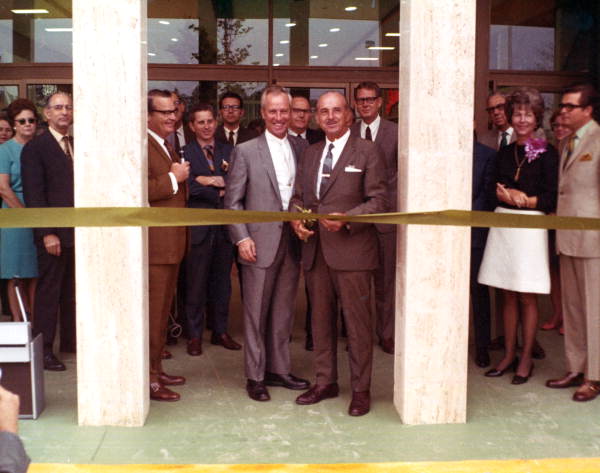
Florida State Senator Mallory E. Horne, center left, with George Jenkins at the opening ceremony of Publix at the Northwood Mall, Tallahassee, Florida, 1969.
Florida’s malls matched their national counterparts in size and grandeur, featuring indoor fountains, impressive sculptures, artificial gardens, gleaming chandeliers, and expansive parking lots.

Sculpture in front of Mendelson’s at the Northwood Mall on opening day, Tallahassee, Florida, 1969.

Fountain at the Dadeland Mall in Miami, ca. 1970.
As malls became a fixture of American consumer culture, they gained a reputation as a place for young people to socialize. With limited spending power, and so often without an alternative place to congregate, teenagers flocked to the malls. There they could take a stroll, chat with friends, and engage in “people-watching”–unknowingly harkening back to Gruen’s original vision of the mall as a type of community center.
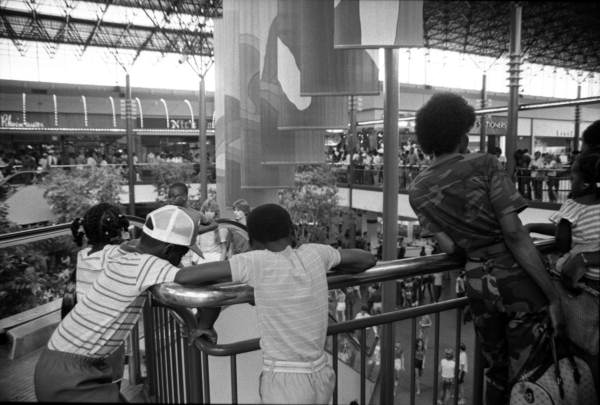
Youngsters “people-watching” at Governor’s Square Mall, Tallahassee, Florida, 1984.
Catering to this new wave of teenage patronage, youth-oriented businesses began to arise within the mallscape–including community college outreach centers, as well as national army recruitment centers.
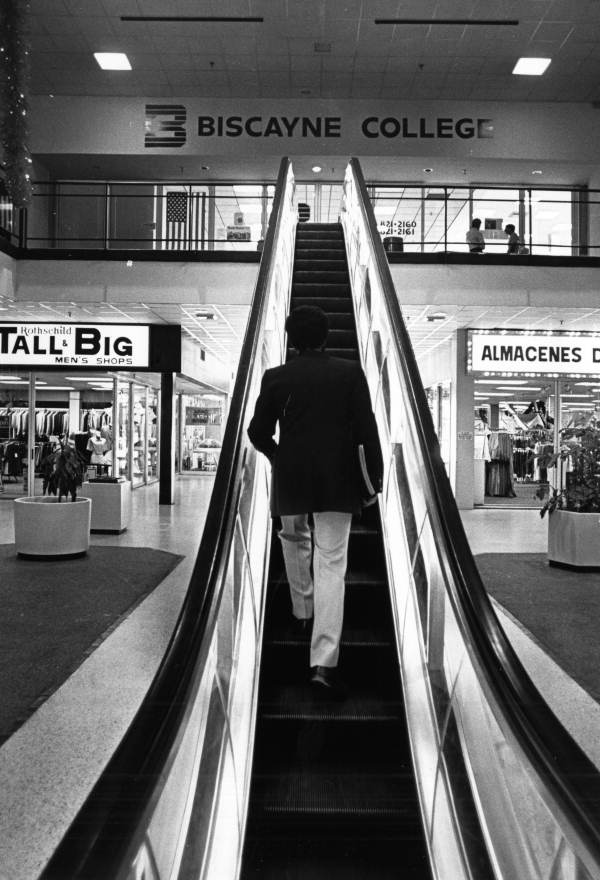
Biscayne College outreach information center in the Palm Springs Mile Mall, Hialeah, Florida, 1980.
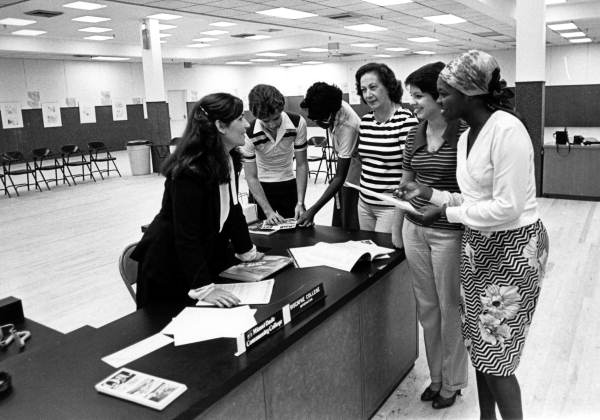
People at the Miami Dade Community College outreach information center in the Palm Springs Mile Mall, Hialeah, Florida, 1980.
However, the place of the mall in Florida’s consumer society began to diminish by the 1990s. With the arrival of big box stores such as Walmart and Best Buy, as well as the rise of online shopping, malls saw a steep decrease in revenue, forcing many to close their doors forever. The Northwood Mall was later repurposed into an office building, while the Tallahassee, Governors Square, Aventura and many other malls across Florida have weathered the changing face of retail, remaining as palatial testaments to the post-war economic boom in America.

View of man posing with mannequins at Colony store in the Northwood Mall on opening day, Tallahassee, Florida, 1969.
Cite This Article
Chicago Manual of Style
(17th Edition)Florida Memory. "Black Friday: The Life and Death of Florida's Shopping Malls." Floridiana, 2016. https://www.floridamemory.com/items/show/324850.
MLA
(9th Edition)Florida Memory. "Black Friday: The Life and Death of Florida's Shopping Malls." Floridiana, 2016, https://www.floridamemory.com/items/show/324850. Accessed November 28, 2024.
APA
(7th Edition)Florida Memory. (2016, November 11). Black Friday: The Life and Death of Florida's Shopping Malls. Floridiana. Retrieved from https://www.floridamemory.com/items/show/324850

 Listen: The Blues Program
Listen: The Blues Program